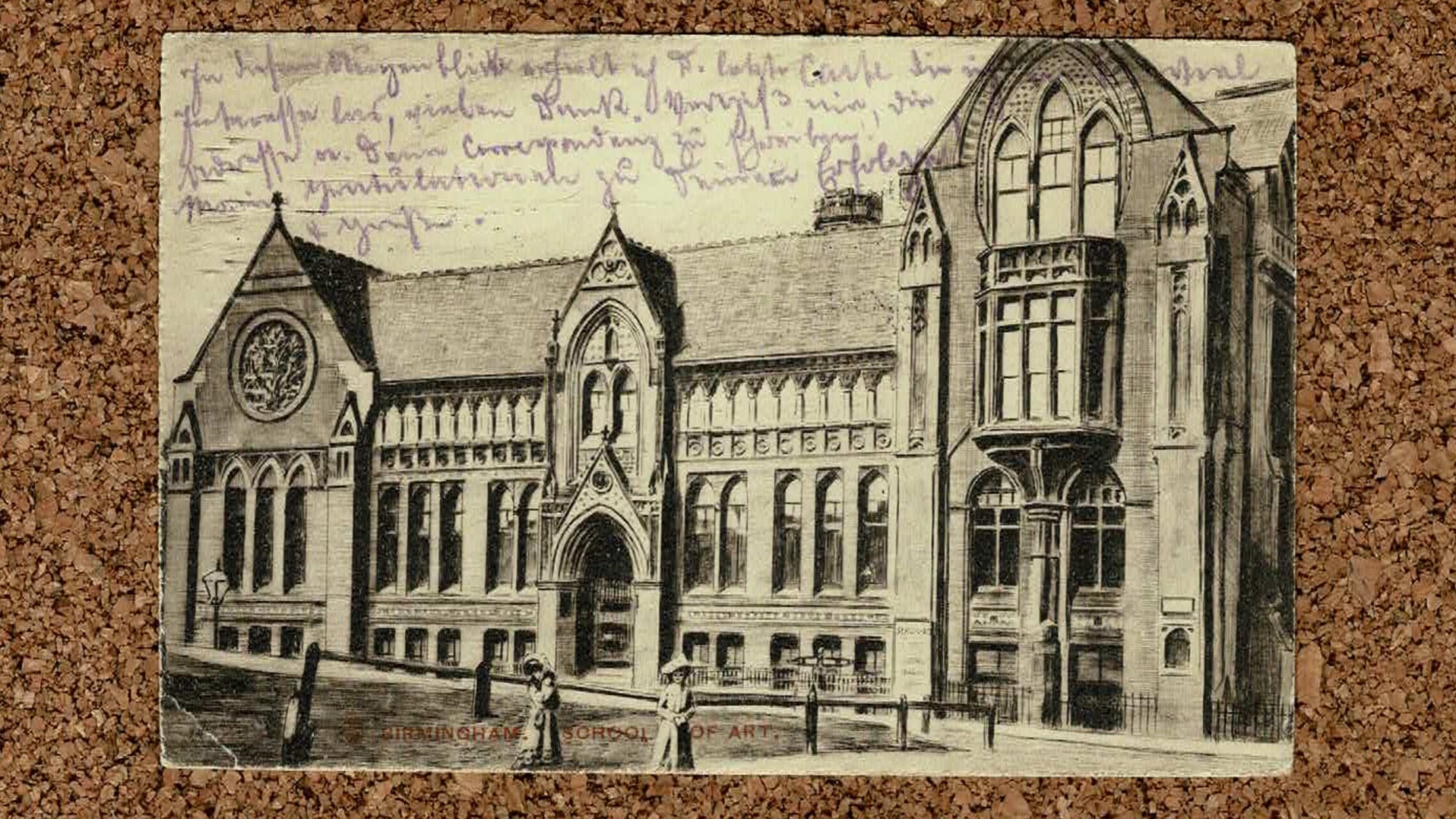Greetings from Birmingham! This is the School of Arts, Birmingham, which had its origins in 1843, and became part of what is now Birmingham City University.
Full disclosure: I’m a governor of BCU and very proud of the institution!
A tale of twelve colleges
Like many civic universities, it is the product of several – at least twelve, on my count – formerly distinct specialist colleges, which have been brought together. And our story starts in 1843, with the establishment of the Birmingham Government School of Design, which was supported by the Royal Birmingham Society of Artists. In 1877 this was taken over by Birmingham Town Council and in 1885 it moved into its iconic buildings – shown on the card – on Margery Street. This was, it is said, the UK’s first municipal school of art.
In 1909 it expanded to include architecture amongst its subjects – this was recognised by the Royal Institute of British Architects in 1923.
College two is the Birmingham School of Music, which was founded in 1886. It grew from the music-related programmes of the Birmingham and Midland Institute, which had been established in 1854 and which continues to thrive today. The school remained attached to the Institute until 1963, when it became independent.
College three is the Birmingham College of Commerce. This was established by 1916 as an offshoot of the Birmingham Municipal Technical School which, like the School of Music, grew out of the Birmingham and Midland Institute. (The Birmingham Municipal Technical School was also the forerunner of Aston University.)
College four is the South Birmingham Technical College which opened in 1961; and College five is the Aston Technical College (not to be confused with Aston University) which opened in 1966 and which changed its name the next year to North Birmingham Technical College.
I hope you’ve been paying attention, because now we get to do some drawing together of threads.
In 1971 Birmingham Polytechnic was created, bringing together these five colleges: the School of Art, the School of Music, the College of Commerce, and the South and North Birmingham Technical Colleges. The polytechnic was headquartered in Perry Barr, where North Birmingham Technical College had been building a new campus, but retained sites across the city.
Now we need to add some more institutions into the mix.
College six is Anstey Physical Training College, founded in 1897 as a private college for women. This, wrote its founder, Rhoda Anstey, offered education in
…Educational Gymnastics, Medical Gymnastics, Anatomy, Physiology, Hygiene, Dancing, Swimming and Games and … [aiming to] prepare girls to take up the work of Physical Education in Schools.
This became the Anstey College of Physical Education in 1949, and was taken over by Staffordshire County Council in 1955.
College seven is the City of Birmingham College of Education, which was founded in 1948 as one of the emergency teacher training colleges. (These were established post-war as a first response to an acknowledged need to increase the number of teachers. The National Advisory Council on Training and Supply of Teachers (NACTST) was set up in 1948 to enable a more settled approach.)
College eight is the Bordesley College of Education, founded in 1963 as a day training college for women teachers.
All of these institutions joined the Birmingham Polytechnic in 1975: this was in line with government policy which encouraged rationalisation of local-authority-controlled colleges into larger units.
Now let’s have institution nine – the Bourneville School of Art. This opened in the early twentieth century as part of the Bourneville model village. In 1988 it merged with Birmingham Polytechnic.
By now the time of the polytechnics was almost at an end, and in 1992 the Polytechnic was granted university status, as the University of Central England in Birmingham.
1995 saw two further institutions join the University: the Birmingham and Solihull College of Nursing and Midwifery, and the West Midlands School of Radiography. Again, this came about as a result of national policy, as previously independent health schools were brought into the university sector.
And now let us have the final institution: college twelve is the Birmingham School of Speech Training and Dramatic Art, founded in 1936. It later became the Birmingham School of Speech and Drama and then the Birmingham School of Acting. It became part of the University in 2005.
So that’s got the institutional story out of the way. We need to talk about three more things: Mapplethorpe; the card; and names.
Corrupting the youth
The University was at the centre of controversy in 1998 when a student took photographs of images by Robert Mapplethorpe – which they intended to use in an essay and which were in a book held in the University library – to a local photo shop for developing and printing. (For younger readers: this is what you used to have to do before the ubiquity of mobile phones with cameras. Crazy times.)
The photo shop considered the images to be unusual (and in order to make this blog safe for work I’m not going to link to them) and informed West Midlands Police. They regarded the images as obscene, and likely, in the terms of the act, “to deprave and corrupt”. They interviewed the VC under caution, who refused to remove the book from the library, on grounds of academic freedom. The matter was referred to the Director of Public Prosecutions, who after six months took a decision not to prosecute. And no, seekers of connections, the DPP at the time was not Sir Keir Starmer.
The Swiss connection
The card itself was sent in 1910 to a Mr Albrik Lűthy (who I believe, thanks to the detective work of my wonderful brother, Dr Stephen Jones, to have been Swiss) in Dartmouth Park Road, London. The writing on the front is in German, and thanks to Dr Linus Ubl of the University of Oxford I believe that it says (when translated into English):
Just now I received your card, which I read with great interest, many thanks! Don’t forget to write with the address and your correspondence. My congratulations on your success and greetings”
It’s a team sport
And finally, names. The University changed its name in 2007 to Birmingham City University, which made it one of a select group across the UK to share its name (once you remove the appendages FC or University) with the local professional football team. So, when you next have to play a round of “University or Football team” at a pub quiz, here are those which could be either:
- Aberdeen
- Blackpool
- Bournemouth
- Cardiff
- Dundee
- Liverpool
- Portsmouth
- Reading
- Southampton
- Sunderland and, of course
- Birmingham City
And I think we can all agree that Birmingham City University gets the prize for sharing not just the town name – but also the word City.














Blackpool? There is Blackpool and the Fylde College, which has just been granted degree awarding powers but I wouldn’t count that.
Err, don’t think there’s a Cardiff City University (or a football team called Cardiff Metropolitan.) Sounds like one of those pub quiz rounds that ends with lots of semidrunken objections, and the quiz-setter having to say that their word is final (ie wrong …)
*Bounville. Not Bourneville
Isn’t the School on Margaret Street (rather than Margery Street)?
re the Mapplethorpe story – around that time and a little later the VC had a toothbrush blu-tacked to the wall next to the door of his office. Apparently so he could grab it on the way out if they came to arrest him for stocking an obscene publication…
Really good article on the myriad thread that make up our now modern institution that is still championing all these areas!
‘…in 1885 it moved into its iconic buildings – shown on the card – on Margery Street.’
Erm, it’s actually Margaret Street.